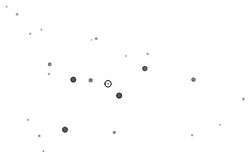Upsilon2 Cassiopeiae
Upsilon2 Cassiopeiae, Latinised from υ2 Cassiopeiae, is a solitary star in the constellation of Cassiopeia, a few degrees to the south of Gamma Cassiopeiae. It has the proper name Castula /ˈkæstjʊlə/, which has been officially adopted by the IAU.[7] The star has a yellow hue and is faintly visible to the naked eye with an apparent visual magnitude of +4.62.[2] Based upon parallax measurements, it is located at a distance of approximately 189 light years from the Sun.[1] The star is drifting closer with a radial velocity of −48 km/s.[5]
| Observation data Epoch J2000.0 Equinox J2000.0 | |
|---|---|
| Constellation | Cassiopeia |
| Right ascension | 00h 56m 39.90413s[1] |
| Declination | +59° 10′ 51.8006″[1] |
| Apparent magnitude (V) | +4.62[2] |
| Characteristics | |
| Evolutionary stage | horizontal branch[3] |
| Spectral type | G8 IIIb Fe−0.5[4] |
| U−B color index | +0.68[2] |
| B−V color index | +0.96[2] |
| Astrometry | |
| Radial velocity (Rv) | −47.73±0.12[5] km/s |
| Proper motion (μ) | RA: −92.085[1] mas/yr Dec.: −45.079[1] mas/yr |
| Parallax (π) | 17.2875 ± 0.1880[1] mas |
| Distance | 189 ± 2 ly (57.8 ± 0.6 pc) |
| Absolute magnitude (MV) | +0.62[6] |
| Details[5] | |
| Mass | 1.44±0.16 M☉ |
| Radius | 10.44+0.24 −0.50[1] R☉ |
| Luminosity | 55.3±0.7[1] L☉ |
| Surface gravity (log g) | 2.75±0.19 cgs |
| Temperature | 4,937±14 K |
| Metallicity [Fe/H] | −0.35±0.03 dex |
| Rotational velocity (v sin i) | 0.54±0.38 km/s |
| Age | 2.20±0.62 Gyr |
| Other designations | |
| Database references | |
| SIMBAD | data |
This is an aging giant star with a stellar classification of G8 IIIb Fe−0.5,[4] where the suffix notation indicates a mild underabundance of iron in the spectrum. With the supply of core hydrogen exhausted, this star has cooled and expanded off the main sequence – at present it has 10[1] times the girth of the Sun. It is a red clump giant, which means it is on the horizontal branch undergoing core helium fusion.[3]
Upsilon2 Cassiopeiae is a barium star, showing an excess of the element barium in its spectrum. This can occur from mass transfer from a more-evolved companion star that later became a white dwarf, although no companion has been detected.[6] It is 2.2 billion years old with 1.44 times the mass of the Sun.[5] The star is radiating 55[1] times the luminosity of the Sun from its enlarged photosphere at an effective temperature of 4,937 K.[5]
Nomenclature
υ2 Cassiopeiae is the star's Bayer designation. In 2016, the IAU organized a Working Group on Star Names (WGSN)[8] to catalog and standardize proper names for stars. The WGSN approved the name Castula for this star on 5 September 2017 and it is now so included in the List of IAU-approved Star Names.[7]
References
- Brown, A. G. A.; et al. (Gaia collaboration) (August 2018). "Gaia Data Release 2: Summary of the contents and survey properties". Astronomy & Astrophysics. 616. A1. arXiv:1804.09365. Bibcode:2018A&A...616A...1G. doi:10.1051/0004-6361/201833051. Gaia DR2 record for this source at VizieR.
- Argue, A. N. (1966), "UBV photometry of 550 F, G and K type stars", Monthly Notices of the Royal Astronomical Society, 133: 475, Bibcode:1966MNRAS.133..475A, doi:10.1093/mnras/133.4.475.
- Puzeras, E.; et al. (October 2010), "High-resolution spectroscopic study of red clump stars in the Galaxy: iron-group elements", Monthly Notices of the Royal Astronomical Society, 408 (2): 1225–1232, arXiv:1006.3857, Bibcode:2010MNRAS.408.1225P, doi:10.1111/j.1365-2966.2010.17195.x.
- Keenan, Philip C.; McNeil, Raymond C. (1989), "The Perkins catalog of revised MK types for the cooler stars", Astrophysical Journal Supplement Series, 71: 245, Bibcode:1989ApJS...71..245K, doi:10.1086/191373.
- Jofré, E.; et al. (2015), "Stellar parameters and chemical abundances of 223 evolved stars with and without planets", Astronomy & Astrophysics, 574: A50, arXiv:1410.6422, Bibcode:2015A&A...574A..50J, doi:10.1051/0004-6361/201424474.
- Bergeat, J.; Knapik, A. (May 1997), "The barium stars in the Hertzsprung-Russel diagram.", Astronomy and Astrophysics, 321: L9, Bibcode:1997A&A...321L...9B.
- Naming Stars, IAU.org, retrieved 16 December 2017
- IAU Working Group on Star Names (WGSN), IAU.org, retrieved 22 May 2016
